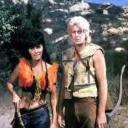Yahoo Answers is shutting down on May 4th, 2021 (Eastern Time) and beginning April 20th, 2021 (Eastern Time) the Yahoo Answers website will be in read-only mode. There will be no changes to other Yahoo properties or services, or your Yahoo account. You can find more information about the Yahoo Answers shutdown and how to download your data on this help page.
Trending News
Which one of these would most likely sustain life?
Which one of these moons would most likely sustain life or liguid water? A moon orbiting 47 Ursae Majoris with a mass of 1 Earth OR a moon around 16 Cygni Bb with a mass of 1 Earth. With both of these moons having atmospheres of course :)
5 Answers
- QuadrillianLv 79 years agoFavorite Answer
You have not told us any of the necessary orbital parameters, or planetary system characteristics, so it is impossible to say.
An object must orbit in the so called "GOldilocks zone". Most importantly (and seldom mentioned), it must have a nearly circular orbit. It is not good enough if the planet has a highly elliptical orbit with an AVERAGE distance in the Goldilocks zone.
The object must be in a system that is stable enough for the planet to exist undisturbed for billions of years. Our solar system has such a stability. It is the only planetary system known to be thus stable.
The mass of the planet is useless. They might be made from shitt for all we know. They must have a suitable composition to initiate and sustain the necessary biochemistry upon which life is based.
Finally, you do realise that pure liquid water is an extremely finicky material. A little too cold and it turns to ice, a little too hot and it vaporises. Liquid water is likely to be extremely rare in the universe. A great deal would have to be known about a planetary system before any estimate could be made of pure liquid water on the surface of any of it's planets
I leave the vote to those advocates of less rigorous sciences.
Cheers!
- Anonymous9 years ago
A moon orbiting 47 Ursae Majoris with a mass of 1 Earth
- 9 years ago
Both are sun-like stars with high metalicity, but 16 Cygni is a triple system with a Jupiter-sized planet in an eccentric orbit only a little more than 1 AU from the star. This would make an earth-like planet in the habitable zone unlikely.
- Anonymous9 years ago
Moon orbiting 47 Ursae.
- How do you think about the answers? You can sign in to vote the answer.





